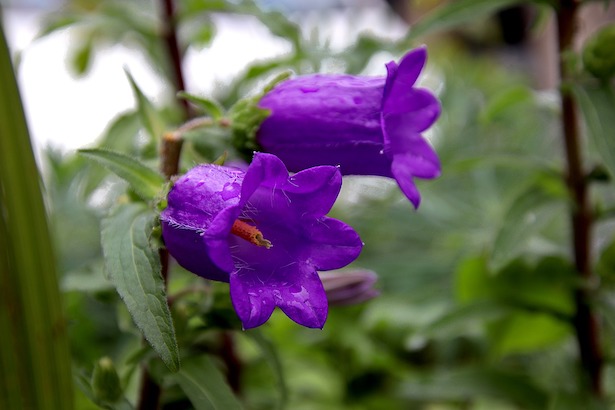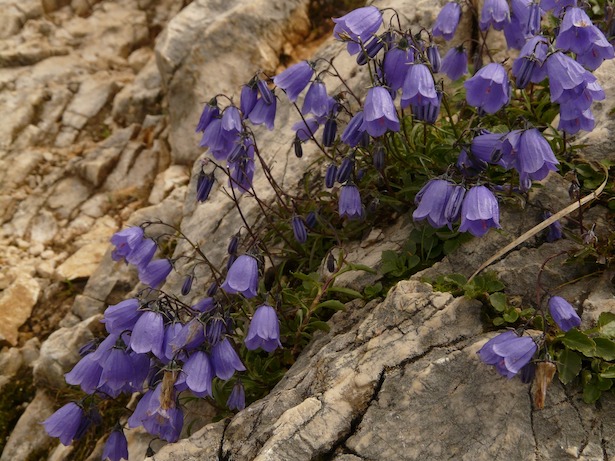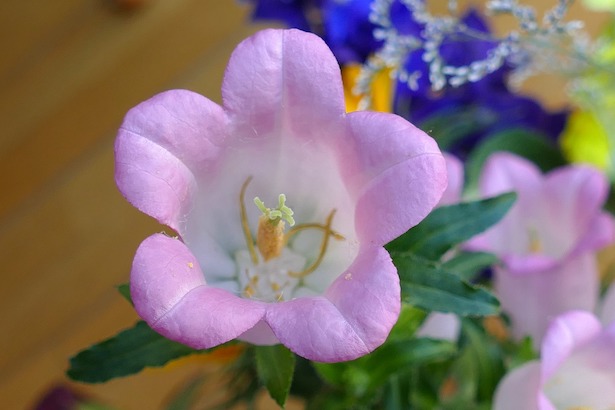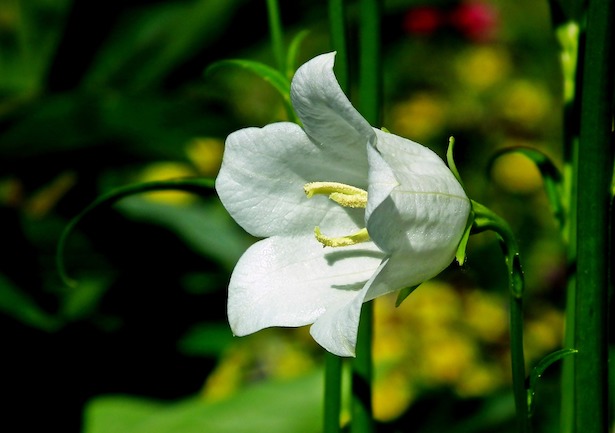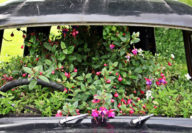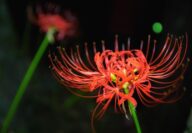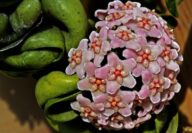The Complete Guide to Bellflowers: Growing Campanula
The bellflower or Campanula is a large group of bell-shaped flowering plants that includes more than 300 different species. While bellflowers are obviously well-known for their bell-shaped blooms, the Campanula genus is so vast that its plants come in many shapes and forms.
Most Campanulas have a tubular or saucer-like shape, but many others are star-shaped, cup-shaped, round or even flat! No matter the shape, bellflowers are sure to bring you joy with their cheerful flowers. Bellflowers also come in a variety of different colors, including blue, purple, violet, white and pink.
Bellflowers are so varied that you can find species that grow upright to 6 feet tall, trailers, creeping plants or tufted dwarf plants.
Due to the huge variety of Campanula plants that are available virtually every gardening and landscaping need can be satisfied.
Stunning gemlike miniature bellflowers are perfect for special settings such as close-up positions in rock gardens, niches in dry walls, raised beds and containers.
Trailing kinds are perfect for baskets, hanging pots or wall crevices.
Some bellflower species are vigorously spreading growers making them perfect groundcover.
Many upright growing types of Campanula, instead, can be used for borders, for cutting or in containers.
In this guide we’ll teach you how to select the perfect bellflower for every gardening need and teach you how to grow and care for your Campanulas.
How to Grow Bellflowers
Campanula species generally have similar growing conditions, with some slight variations between them. Here you’ll find the information you need to grow most bellflowers. In the Bellflower Species and Varieties section you’ll find more specific indications for each campanula species.
Blooming Period
The range for Campanula species to bloom is from early spring through summer. However, a large number of bellflowers bloom during summertime and some extend to late summer, with others occasionally blooming in early fall. Blooming times for bellflowers may also be anticipated with increased exposure to light and can also be delayed for many species in case of dry summers.
Climate and Temperature
Most bellflower plants are very cold hardy plants; they can be hardy to USDA zone 3. This means that they can easily be grown even in the northern most states in the US. Most available campanula species will be hardy to USDA zones 5.
Many bellflower species will have trouble growing in warm areas, especially if those areas are dry. Bellflowers also grow best in areas where the nighttime temperature remains cool.
Light
Bellflowers will thrive in partial shade to full sun.
However, it’s fundamental to adjust sun exposure based on the climate of your area. If the area you are growing your bellflowers in is warmer, it is best to prefer partial shade and avoid harsh afternoon sun. In colder areas, especially with mild summers, bellflowers will benefit from the extra sun for copious blooming.
Watering
Campanulas require moist soil, so water during dry periods in spring and summer. Water whenever your bellflower’s soil begins to dry out. Take care not to overwater your plant, as it will develop root rot if it is left in soggy soil.
Soil
Bellflowers prefer well-drained soil with a pH of 6 to 8; however, bellflowers can tolerate almost any range of soil acidity, including highly acidic soils, with a low pH. Bellflowers often can survive in nutrient-poor soil, especially those species that tend to be most invasive.
Rather than soil pH it is more important that campanulas are maintained in moist soil, with good drainage. However, if the soil is excessively moist, it will cause root rot.
Fertilizing
To promote healthy and extended blooming for campanulas, apply a balanced NPK 10-10-10 fertilizer once, the month before it should begin to bloom. To avoid overfertilizing bellflowers, dilute the fertilizer with tepid water before applying.
Propagation
Bellflowers propagate from both seeds and rhizomes.
When sowing bellflowers from seed, they usually bloom the following year. They can be sown directly in the garden or indoors and successively transplanted.
If you sow campanula seeds in the garden, they need to be planted during spring or early summer, while if sown indoors and then transplanted, they need to be sown around 2 months before transplanting.
Problems, Pests and Diseases
Bellflowers tend to be relatively pest and disease free.
Nonetheless, bellflowers can be attractive to slugs; if this is the case you will see holes in your bellflower’s foliage.
Aphids may also affect your plant, causing yellowed leaves or damaging growth. As soon as you see signs of aphid infestation apply insecticide.
The most common problem bellflowers encounter is root rot due to overwatering.
Occasionally, campanulas may be affected by the fungal parasite that causes rust disease in wet or humid climates. Rust disease will cause rust-colored spores on your bellflower’s leaves. If this is the case, remove infected leaves, otherwise it will spread to healthy leaves.
Bellflower Species and Varieties
In the following list you’ll find some of the most popular bellflower species and varieties with their full specifications and recommendations for landscape use.
Upright Growing Bellflowers
Campanula Glomerata
Campanula glomerata, also known as the clustered bellflower or Dane’s blood, is an upright growing perennial bellflower that also grows erect side branches. The clustered bellflower grows from 1 to 2 feet in height with an explosion of tightly clustered violet-blue flowers that grow at the end of its stem. Its flowers flare at the mouth, with its beautiful 1-inch long petals. Because campanula glomerata’s flowers grow in profuse clusters, it earned the name glomerata, which means “agglomerated”. Flowers may also grow in pockets along the stem.
The clustered bellflower’s stem is somewhat thick and hairy, with broad green wavy edged basal leaves and toothed stem leaves. Compared to other campanulas, the clustered bellflower grows significantly more foliage.
Campanula glomerata blooms around June or July for 2 to 3 weeks.
The clustered bellflower is cold-hardy to USDA zones 3 to 8 and prefers slightly calcareous soil. If you grow this bellflower in warmer areas, plant it in partial shade.
Campanula glomerata is a great bellflower for shaded borders or large rock gardens, for a perfect accent.
Two recommended types of campanula glomerata are “Superba”, which grows intensely purple flowers and “Alba”, which is a white-flower variant.
Campanula Lactiflora
Campanula lactiflora, also known as the milky bellflower, is an erect growing perennial bellflower.
The milky bellflower grows can grow to about 3 to 5 feet tall and has oblong pointed green leaves that grow 2 to 3 inches in length along the stem.
Campanula lactiflora’s beautiful flowers are broadly bell-shaped to star-shaped and grow to about an inch in length. Their colors usually range from white to pale blue, but some purple and pink varieties also exist. These bellflowers grow at the end of branches in profuse drooping clusters. Amongst its award-winning cultivars are the white “Alba”, the violet blue “Pritchard’s Variety” and the light pink “Loddon Anna”.
This bellflower is cold-hardy to USDA zones 5 to 8. It is resistant to lack of light and dry areas as well as being long living.
The milky bellflower blooms profusely from July to September.
This is a great plant for use in borders, especially at the back of borders.
Campanula Latifolia
Campanula latifolia, also known as the large campanula, the giant bellflower or the wide-leaved bellflower is one of the tallest bellflowers available, reaching a height of 3 to 4 feet, and rarely up to 5 feet.
One of the more popular bellflowers, campanula latifolia is often grown as an ornamental plant due to its stunning pendulous purplish-blue tubular flowers. The giant bellflower’s flowers are also large, growing up to 2.5 inches long, initially erect and then drooping.
This bellflower is also noted for its large green basal leaves, which can grow up to 6 inches long and are toothed and hairy. In fact, its species name, campanula latifolia, is given by its large leaves, as latifolia means broad-leaved in Latin. From its large leaves, its hairy and branchless stems grow with flowers growing in axils alongside the stem and smaller, more pointed leaves than at the base.
This bellflower is somewhat less cold-hardy than other bellflowers, with its hardiness listed at USDA zones 5 to 8, though it may tolerate down to zone 4.
The giant bellflower usually blooms around July, but can sometimes blooms later, up to September.
Campanula latifolia is a beautiful plant, but its stem looks a bit rough, making it best for wild or rustic settings. It can also be used in borders, but preferably in the background. Mass planting is also a good choice, creating a stunning spectacle in blooming season.
Campanula Medium
Campanula medium, also known as Canterbury bells, Coventry bells or Cup and Saucer, is an annual or biennial bellflower. Its species name, campanula medium, is given by the fact that it has middling characteristics within the spectrum of campanulas, in terms of size, foliage and flowers.
Canterbury bells grow 2 to 3 feet tall on sturdy erect stems, with large wavy basal leaves that grow 6 or 7 inches long and stem leaves that are about half the size.
Campanula medium’s beautiful flowers are urn-shaped, growing 1 to 2 inches across, in singles or doubles and growing loose open clusters. Its flowers can come in a range of colors due to its extensive number of varieties and cultivars: its flowers can come in lavender, purple, violet, blue, pink or white flowers.
Plant hardiness for Coventry bells is listed at USDA zones 4 to 9, but it will not tolerate hot temperatures, especially in dry areas.
This bellflower blooms from May to July and it maintains full bloom for an extremely long period of time compared to other bellflowers.
Campanula medium is a great choice for mass planting in borders or flower beds.
One of the most popular varieties is “Calycanthema”, commonly known as Cup and Saucer, which is a biennial plant.
Campanula Persicifolia
Campanula persicifolia, also known as the peach-leaved bluebell, is an herbaceous upright growing perennial bellflower.
Growing 2 to 3 feet tall, campanula persicifolia, has a slender fast-growing stem with leaves that grow at its base. Its green basal leaves are 4 to 8 inches long and smooth-edged, while its stem leaves are 2 to 4 inches long and shaped like peach leaves, therefore lanceolate.
Known as one of the more popular alpine bellflowers, the peach-leaved bluebell, produces open, cup-shaped flowers that are about 1 to 2 inches long that grow from short side shoots, out of its sturdy stem. Due to its popularity, this bellflower has been bred into a number of varieties and cultivars to include a range of colors that include blue, purple, pink and white.
This bellflower tends to bloom in June but sometimes blooms later in the year, especially during colder years, occasionally blooming as late as September.
The peach-leaved bluebell is hardy from USDA zone 3 to 8 depending on its variety. Most varieties are hardy at least from USDA zone 5 to 8.
Campanula persicifolia is the perfect plant for borders.
Especially popular varieties of campanula persicifolia include “Telham Beauty”, which grows 3-inch wide blue flowers and taller than 3 feet, the double-flowered “Blue Gardenia” and “White Pearl”.
Campanula Punctata
Campanula punctata, also known as the spotted bellflower, is a clump-forming perennial bellflower that grows upright, growing 1 to 2 feet in height and wider spread.
This bellflower is noted for its drooping tubular flowers that has spots on the inside, as indicated by the species name, campanula punctata, where punctata means “spotted” in Latin. Its flowers usually grow about 2 inches in length and can be white, pale blue or lavender. One of its most popular varieties is “Cherry Bells”, which has pink flowers with white edges.
Its mid green leaves are ovate and toothed and can grow upwards of 3 inches in length.
The spotted bellflower is cold-hardy to USDA zones 5 to 8.
This bellflower blooms profusely from early to mid-summer and is a good plant for border use.
Campanula Rotundifolia
Campanula rotundifolia, also known as Bluebell of Scotland or Harebell, is a perennial upright growing bellflower. The bluebell can grow from 6 to 20 inches in height, with a slender long stem that can have multiple branches.
The bluebell’s flowers are broad and bell-shaped, with a width of about 1 inch and can have various tones of bright blue to lavender, sometimes with white shades. Its flowers slightly nod, like many other bellflower species and can grow as single flowers or in open clusters.
Campanula rotundifolia’s leaves are grass-shaped, reaching 2 to 3 inches in length and are green, with occasional undertones of gray. The bluebell’s basal leaves, instead, are rounded, from which it derives its species name, rotundifolia, which means “rounded leaves”.
Bluebells usually bloom from July to August and can tolerate dry and nutrient-poor soils. The campanula rotundifolia species will not tolerate heat and grows best in cold climates, especially cool summers; it is hardy from USDA zones 3 to 6 but it may begin experiencing damage below zone 6.
Bluebells are the perfect plant for use in rock gardens, borders or for naturalization under deciduous trees.
Campanula Trachelium
Campanula trachelium, also known as the nettle-leaved bellflower or bats in the belfry, is a bushy perennial upright growing bellflower.
The nettle-leaved bellflower grows 2 to 3 feet tall, without branches but with nettle-shaped green toothed leaves that also grow along its stem. Its slightly nodding flowers are openly star-shaped and tubular, reaching nearly 2 inches in length and come in colors from lilac to blue purple. They grow both at the top of their stem and alongside its upper part.
Campanula trachelium is cold-hardy to USDA zones 5 to 8.
This beautiful bellflower blooms from July to September but requires more nutrient-rich soil compared to other bellflowers.
This bellflower can be used as an accent plant, in borders and looks great in mass plantings.
Trailing and Mounded Bellflowers
Campanula Carpatica
Campanula carpatica, also known with the species name campanula turbinata and with the common use names, Carpathian harebell and the tussock bellflower, is a relatively low-growing herbaceous perennial bellflower.
The tussock bellflower grows in a mounded habit, in compact leafy tufts, with spreading and branching stems. While this bellflower tends to grow from about 6 to 12 inches in height and width, it can occasionally grow to 18 inches tall.
A profuse bloomer, Campanula carpatica grows with stunning open bell or cup-shaped purple, blue or white flowers 1 to 2 inches wide, grow from erect stems that rise above its foliage.
Campanula carpatica’s smooth bright green leaves grow to about 1 to 1.5 inches in length and are toothed and wavy.
As indicated by its name, Carpathian harebell, this bellflower is native to the Carpathian Mountains and is therefore particularly cold-hardy, listed at USDA zones 3 to 8.
Campanula carpatica’s blooming period is around late spring, when a huge number of stunning flowers come to life.
This bellflower is excellent for foreground in borders and edging, as well as in rock gardens and for groundcover.
Because Campanula carpatica is an award-winning plant, it has been cultivated widely. A couple of dwarf varieties of this bellflower exist, amongst which the most famous are “Blue Chips” and “White Chips”.
Campanula Isophylla
Campanula Isophylla, also known as Italian bellflower, trailing campanula, falling stars or star of Bethlehem is a trailing perennial bellflower.
As indicated by its name, the trailing campanula has trailing or hanging stems, which can grow to 2 feet long. Its heart-shaped leaves are light green and toothed and can grow to about 1.5 inches both in length and width.
The Italian bellflower’s flowers are absolutely stunning. They are star-shaped and can grow in different colors depending on its variety. The species plant grows in pale blue, but the most popular variety is the Campanula Isophylla “Alba”, which has white flowers that are also larger than its usual inch-wide flowers. The “Mayi” variety is also very popular, with gray leaves and large lavender blue flowers.
Campanula Isophylla is one of the least hardy bellflowers, as it is only hardy to USDA zones 7 to 10 and is not very frost-resistant. It is also a bellflower that has delicate stems and must be treated with care.
The Italian bellflower blooms profusely in late summer to fall, however, with increased exposure to light it may bloom earlier.
This bellflower is perfect for hanging baskets, the top of walls, wall pots or rock gardens. It is also suited for use as small-scale groundcover, especially on slopes.
Campanula Portenschlagiana
Campanula portenschlagiana is also known as campanula Muralis, Dalmation bellflower or the wall bellflower.
This bellflower is a low growing plant that grows with a mounding habit, with flowers sprouting out of a mat of foliage. This evergreen perennial bellflower grows from 4 to 7 inches in height and about 20 inches in width.
The Dalmatian bellflower has flaring violet blue bell-shaped flowers that reach an inch in length and grow in groups of 2 or 3 on each semi-erect stem.
Campanula portenschlagiana’s mounded habit is made of deep green leaves that are rounded and heart-shaped, with toothed and wavy edges.
This bellflower blooms between May and August but may experience re-blooming again during Fall.
Campanula portenschlagiana is an alpine plant that is hardy to USDA zone 3.
This is a great bellflower to use for groundcover or for edging. It is strongly resistant and grows moderately fast without becoming invasive. As indicated by its name, wall bellflower, it can grow into crevices in walls and pavements.
The “Resholt” variety of campanula portenschlagiana has the deepest blue flowers and is an excellent selection.
Campanula Poscharskyana
Campanula poscharskyana, also known as the Serbian bellflower or the trailing bellflower, is a semi-evergreen perennial trailing bellflower.
This bellflower is particularly appreciated due to its beautiful star-shaped blue-lilac to lavender flowers.
This spreading species of bellflower grows numerous leafy branches, with its flowers growing off of semi-upright stems that reach a height of at least 12 inches. Its green and irregularly toothed foliage is long and heart-shaped. Its moderately hairy leaves have a wide range of width and length: from 1 to 3.5 inches long and 0.5 to 3 inches wide.
The Serbian bellflower is a vigorous grower that blooms from spring to early summer.
This bellflower is hardy to USDA zones 3 to 8 but survives best during winter in the 40 to 50°F temperature range. It is also more adaptable to coastal and warmer climates compared to other bellflowers, up to zones 10 to 12.
The trailing bellflower is great for shaded borders, especially near pools, or in shaded rock gardens. It is also a great plant to use for small area groundcover. It also fits very well with begonias and fuchsias.
Because of its particularity, campanula poscharskyana has been cultivated extensively into a number of varieties. Of particular note are the prized “Stella” cultivar and “Blue Waterfall”, with its gleaming blue bellflowers.
An additional interesting fact about the trailing bellflower is that its leaves are edible and can be consumed in salads.
Campanula Rapunculus
Campanula rapunculus, known as the rover bellflower, rampion bellflower or the Rapunzel bellflower is a biennial plant, with leaves growing the first year and flowers blooming in the second year.
The particularity of this plant is that both its leaves and its roots are edible. In fact, it was often grown in vegetable gardens in Europe for its edible properties, its leaves similar to spinach and its roots similar to radishes.
Its flowers also happen to be beautiful, with funnel-shaped flaring flowers of a lilac-blue to white color.
The rover bellflower’s edible ovate leaves grow from 1 to 4 inches long and are slightly toothed and grow in a slightly mounded habit on the ground. Its stems then grow up to 3 feet in height, along which its attractive flowers bloom.
This bellflower is cold-hardy in USDA zones 4 to 8 and blooms during early summer of its second year.
Its species name, campanula rapunculus, is due to its turnip-shaped roots, as rapa means “turnip” in Latin.
Aside from use in vegetable gardens, this bellflower can be planted for use in borders.
Campanula Rapunculoides
Campanula rapunculoides, also known as creeping bellflower or rampion bellflower, is extremely similar to campanula rapunculus. Its species name, campanula rapunculoides, means “rapunculus-like”.
It is also sometimes known as “the evil twin” of the campanula rapunculus, due to its extremely invasive nature.
While like campanula rapunculus, campanula rapunculoides does have beautiful funnel-shaped flowers that are violet, pale blue, white, and also grows with stems that sprout from a mounded habit of leaves, it is extremely dangerous to plant. Its roots grow vigorously even in the most difficult of soils and is difficult to eradicate. It propagates profusely in multiple ways, choking out the other plants.
As beautiful as it may seem, we strongly recommend avoiding planting campanula rapunculoides in your garden, and if you happen to find it growing in your garden, eradicate it a soon as possible.
Published by Davide Zancan on 18 Novembre 2020
